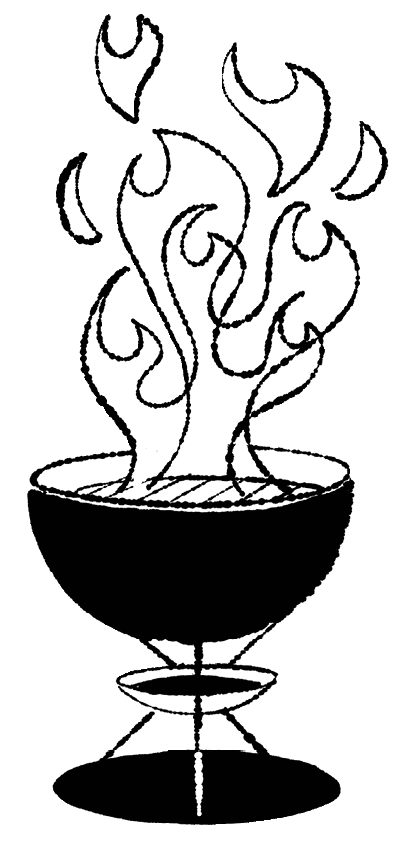grilling
Controlling the fire is the key to perfect, flame-seared meats and veggies. Get a handle on the terminology, techniques, and safety tips. then fire up the grill to get your backyard party started.

direct grilling
involves placing food directly over an intense heat source with the lid closed. It works best with foods that grill in 30 minutes or less, including tender, thin, and small cuts of food. To cook evenly, turn food once halfway through grilling time.
FOODS TO DIRECT-GRILL
Burgers ■ steaks ■ chops ■ chicken pieces ■ brats ■ hot dogs ■ vegetables
indirect grilling
is usually done at lower temperatures with food positioned on the grill rack to the side of the heat source with grill cover closed. This slower grilling method works like an oven and is used for foods that take longer to cook. The heat circulates, so turning food isn’t necessary.
FOODS TO INDIRECT-GRILL
Large roasts ■ ribs ■ whole chicken and turkey ■ whole fish

gas grills
are clean, convenient, and easy to control. Follow the manufacturer’s directions to preheat your gas grill and to use for indirect cooking (opposite).
ADJUSTING HEAT
Adjust burners to higher or lower settings as needed.
charcoal grills
take more effort but are worth it for the smoky flavor.
PREP
About 25 to 30 minutes before cooking, remove the grill cover and rack and open all the vents.
DIRECT COOKING
Use enough briquettes to cover the charcoal grate with one layer. Pile briquettes into a pyramid in the center of the grate for lighting (opposite).
INDIRECT COOKING
The number of briquettes you need to use is based on your grill size (chart, opposite).
ADJUSTING HEAT
If grill is too hot, raise rack, spread coals apart, close air vents halfway, or remove some coals. If grill is too cool, use long-handled tongs to tap ashes off burning coals, move coals closer, add briquettes, lower rack, or open vents.
cleaning grates
To prevent flare-ups and stuck-on food, clean grates after each grilling session. Particles release easier when the grate is still hot (but let coals die down slightly before scrubbing).

1
Scrub steel grill racks with a long-handled iron-bristle brush and enameled grates with a brass-bristle brush. Wear heat-resistant mitts.
2
If you don’t have a brush, scrub off burned bits of foods with a sturdy long-handled metal spatula. Or grip a ball of foil with tongs and rub grates.
3
For thorough cleaning, after the grill grate has cooled completely, wash using mild soap and steel wool; rinse well. Let stand to dry.
about charcoal
Fire up the coals using a fire starter or an electric starter or place briquettes in a chimney starter. (If you use liquid starter, wait 1 minute before igniting the fire.) Before grilling, let the fire burn 20 to 25 minutes or until the coals are covered with a light coating of gray ash.
Grill diameter
18½ INCHES
Briquettes to start
32
Briquettes to add for longer grilling
10
Grill diameter
22½ INCHES
Briquettes to start
50
Briquettes to add for longer grilling
16
Grill diameter
26¾ INCHES
Briquettes to start
60
Briquettes to add for longer grilling
18

direct cooking
Use long-handled tongs to spread hot coals evenly across the bottom of the grill, covering an area 3 inches larger on all sides of the food you are cooking.
indirect cooking
Use long-handled tongs to arrange coals around the edge of grill bottom. Place a disposable foil pan in center (drip pan). Or place coals on one side of grill; place drip pan on other side.

weather & temp
Weather can influence coal temperatures, and not everyone judges temperature alike. So use timings given with each recipe as a guideline and watch foods on the grill. Adjust heat when the temperature isn’t right (opposite).
Flare-ups
Fat and meat juices that drip onto coals can cause flare-ups. If this happens, move food away from the flare-up and close the lid. If necessary to put out flame, close vents (or turn off gas). As a last resort, mist with water in a spray bottle.

HOW HOT IS HOT?
Check the temperature of the coals using a built-in or separate grill thermometer. Or use the hand test to test the heat level of your grill: Hold your palm above the heat source close to the cooking level and time how long you can comfortably keep it there.
Hot (high)
(400°F to 450°F) 2-second or less hand count
medium-high
(375°F to 400°F) 3-second or less hand count
medium
(350°F to 375°F) 4-second or less hand count
low
(300°F to 350°F) 5-second or less hand count
grill safety
position grill in a well-ventilated area at least 10 feet away from trees, houses, and combustible materials. Never grill inside a garage, porch, or enclosed area.
keep children and pets a safe distance from the hot grill.
use heat-resistant mitts and tools with long handles.
have a fire extinguisher handy in case of emergency. Do not pour water on a grease fire.
never leave a grill unattended or try to move it while it is in use or is still hot.
periodically test your gas grill for leaks and clean the venturi tubes regularly according to the manufacturer’s directions.
extinguish coals by closing vents and lid. Let ashes cool 24 hours before disposing of them.
let the grill cool completely before covering or storing it.